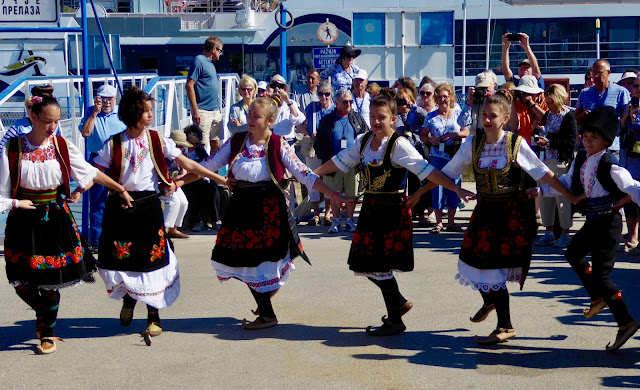We can walk from the ship to town center and our downriver speed has given us extra time to do so. Fortunately, our guide is ready and it is Leveler flat, although initially the surface is uneven in places.
 |
| Rose Freedom Square. Photos © by Judy Wells. |
 |
| Opera House. Photo © by Judy Wells. |
 |
| Trinity Church. Photos © by Judy Wells. |
 |
| Interior, Trinity Church. Photo © by Judy Wells. |
Warning: The priest followed our group out like an angry storm cloud, insisting to our guide that anyone who visited his church should have paid. Our guide glowered back, informing him that no one in his country pays to enter a church. Don't be browbeaten by this or any other priest. Donate, light a candle but only if you want.
We realized that Romania and Bulgaria are the two poorest of the Balkan countries but the incident put a bad taste in our mouths and a damper on the day.
Back aboard, we listened to and watched icon painter Tiva as she made us feel better about the Eastern Orthodox in Bulgaria.
 |
| Icon by Tiva. Photos © by Judy Wells. |
Tip from Tiva: If you are buying an icon, it should be blessed by an Eastern Orthodox priest and hung on an eastern wall.
Veliko Tarnova
The next day we head toward the Balkan Mountains, an extension of the Carpathians, passing the inevitable fields of sunflowers and corn until the terrain began to get more mountainous.
Veliko Tarnova was the Medieval capital of Bulgaria, 1186 to 1393, until the Turks destroyed it. Today, a town of 70,000, it is famous for the production of rose oil, a necessary ingredient in the better perfumes and an export of Bulgaria for 350 years.
Our guide explained that to produce the best oil, the petals must be picked between 4 a.m. and dawn. A gallon of the oil sells for $1,700 and a billion tons are exported annually.
 |
| Medieval center or .... Photos © by Judy Wells. |
 |
| ... Veliko Tarnova. |
We are given a choice, visit the fortified hill fort and the remains of the medieval town or go on and have more time to explore the modern town.
Tip: There are more than 360 steps up to the old town and its cobblestones. The views are lovely but I chose to take pictures at the road level then go to town, the better decision according to those who went to the fort.
Veliko Tarnova is a visual delight, a blend of old, new and quirky.There are slopes and hills but they are manageable as are the few sets of stairs- uneven but no more than six or seven steps at a time - you encounter.
The winding street of craftsmen, the town's main street in the 19th century, is filled with the workshops/stores of jewelers, wood carvers, coppersmiths and artists.
It covers several blocks, each winding higher. Sundries stores sell creams, ointments, powders, perfumes featuring rose oil and small vials of the oil itself. Power boxes and some storefronts are painted with light-hearted images instead of graffiti.
Narrow alleys and lanes elbow off temptingly.
We regroup for lunch at a hotel with Bulgarian college students who are studying languages. The local sauvignon blanc wine is quite good. A little more time to explore the town ends much too quickly. I could have used hours more but wouldn't have missed our next stop for anything.
Arbanasi
This village has been named an architectural and museum preserve, an open air look at what this successful trading center was like in the 17th and 18th centuries.
Our first stop was at a former monastery, site of the Church of Saints Archangels Michael and Gabriel. We approach up a lane lined with daisies to a tree-shaded plateau with expansive views across the hills and valleys.
Plain ochre stone on the outside, inside the church glows with the rich colors of original frescoes.
Intimate and welcoming, female saints are depicted in a starry sky, and we are charmed and awed.
As if that weren't enough, we are treated to a brief concert of a cappella Slavic chants by the Orthodox-VT quartet.
We exit exalted.
We visit one of the houses, one built by a prosperous trader. It is interesting, but the experience at the church stays with us. Truly a satisfying, memorable day.
Leia Mais…


















































